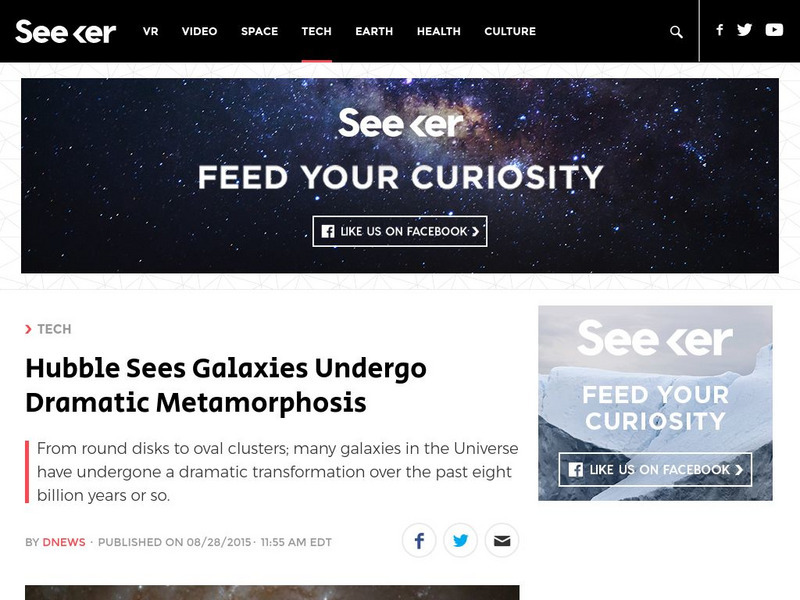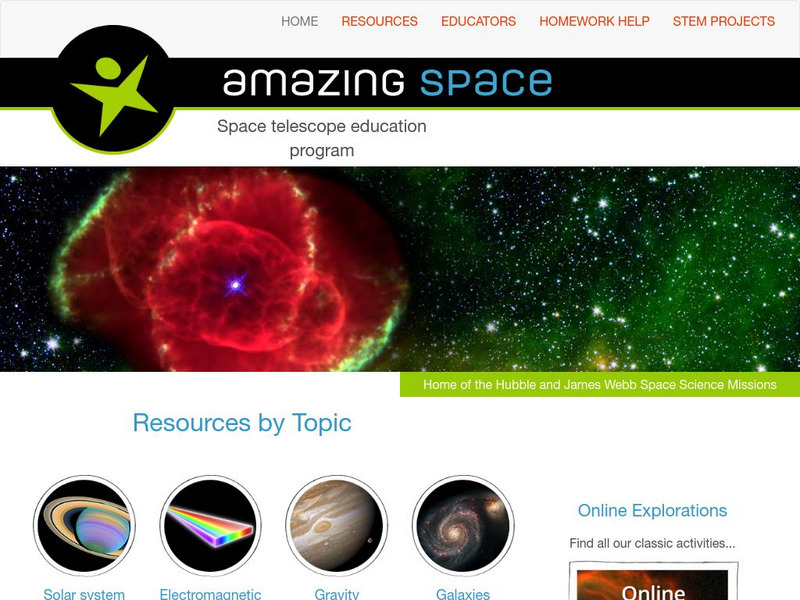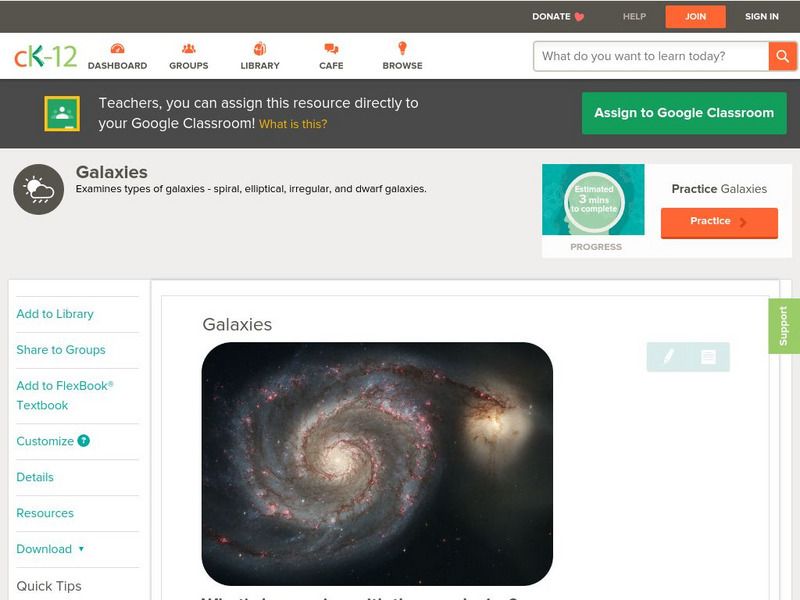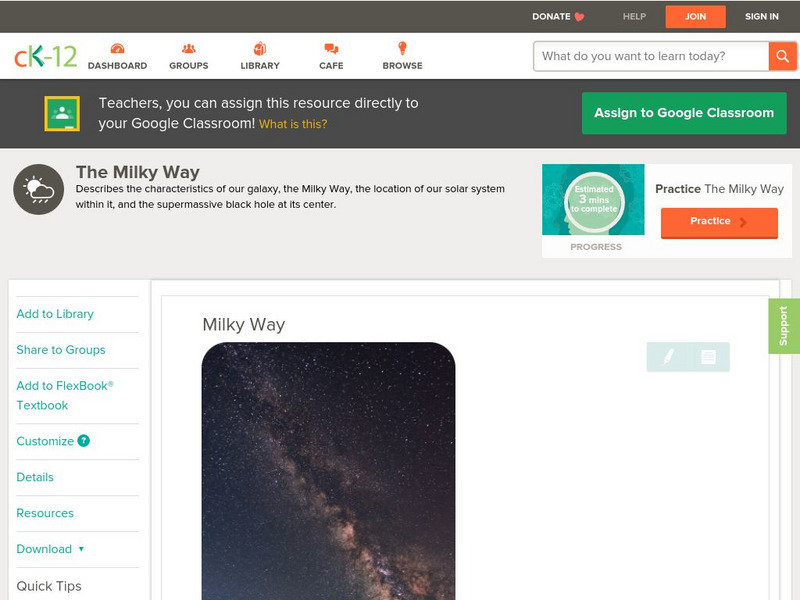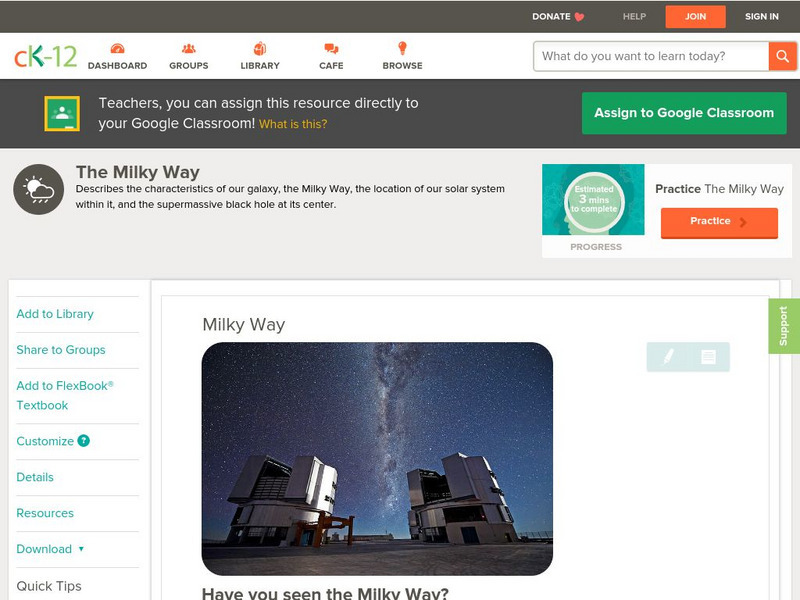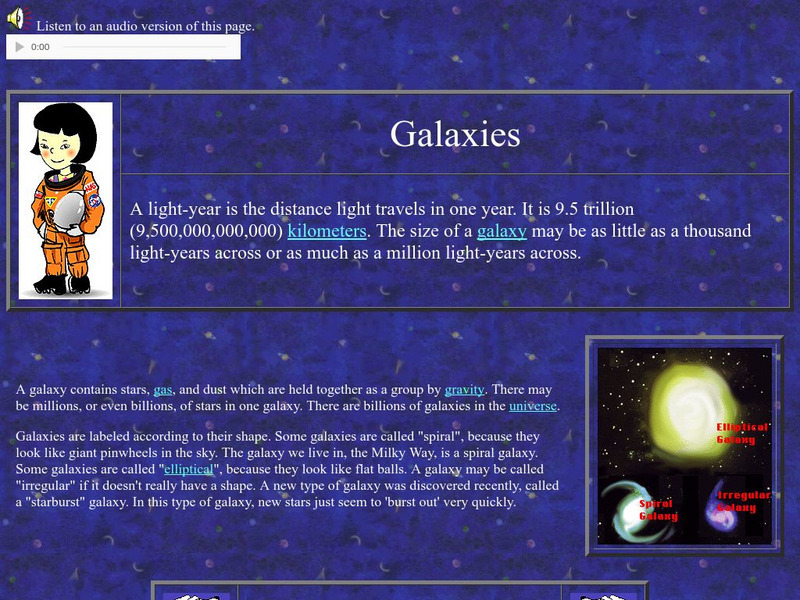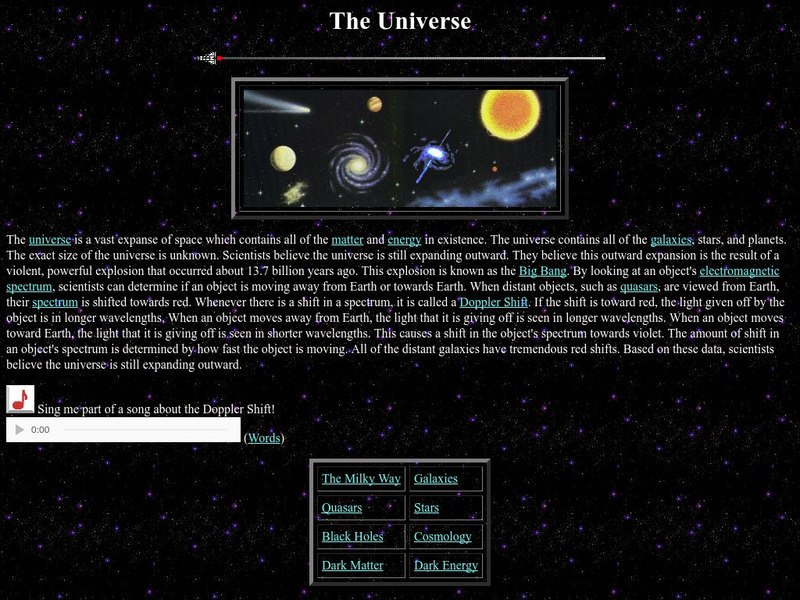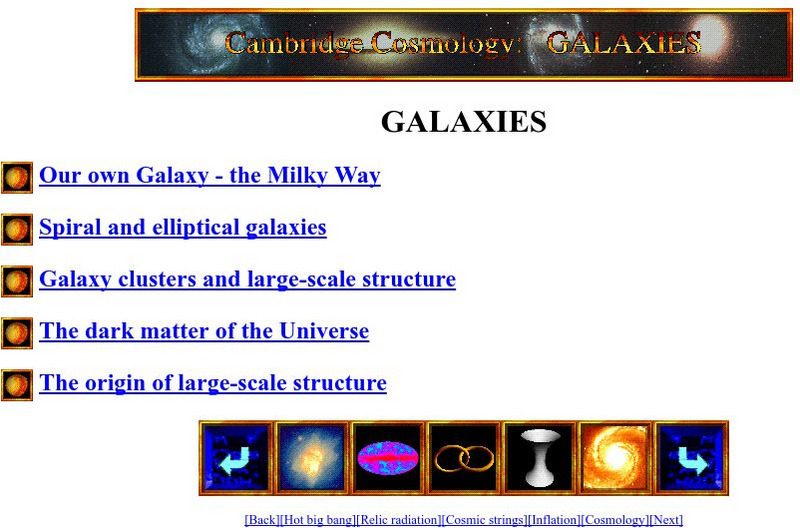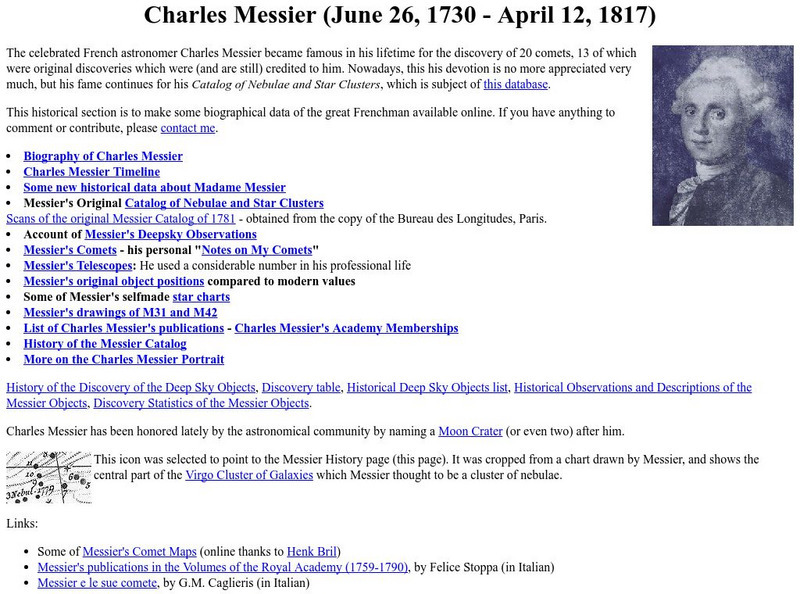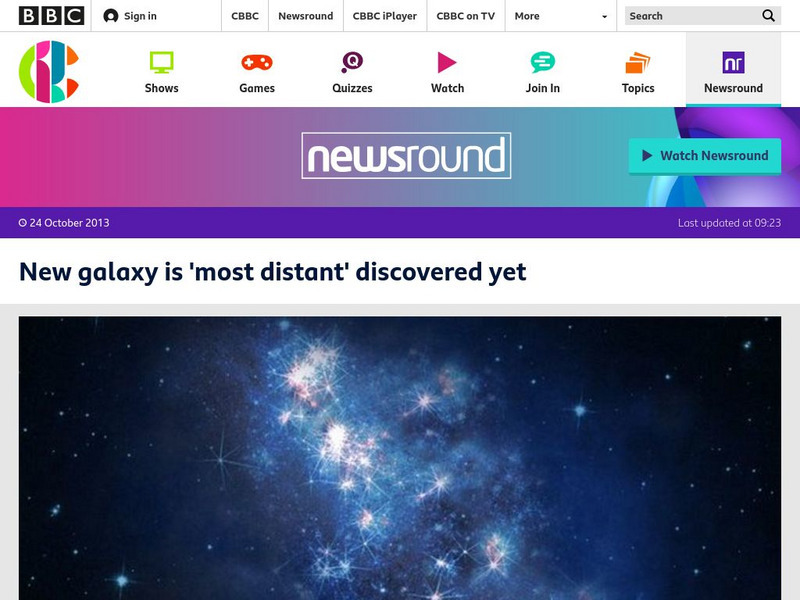Seeker
Seeker: Galaxies Undergo Dramatic Metamorphosis
Article reports on the changes galaxies have experienced that can be observed with the Hubble telescope.
Space Telescope Science Institute
Space Telescope Science Institute: Amazing Space
Amazing Space promotes the "science and majestic beauty of the universe for use in the classroom." Here you can find learning activities, lesson plans, teaching guides, and helpful tips for students eager to learn about space and space...
Space Telescope Science Institute
Amazing Space: Galaxies
What is a galaxy? What is the name of our galaxy? Site offers answers to these questions as well as many more.
CK-12 Foundation
Ck 12: Earth Science: Expansion of the Universe
[Free Registration/Login may be required to access all resource tools.] Recognize how redshift suggests the universe is expanding.
CK-12 Foundation
Ck 12: Earth Science: Galaxies
[Free Registration/Login may be required to access all resource tools.] Examines galaxies and how they are divided into three types according to shape.
Space Telescope Science Institute
Hubblesite: News Center Release Archive
This site from Hubblesite has a very long list of Hubble Space Telescope Images listed by subject. General categories of subjects include Solar System, Stars, Nebulae, Star Clusters, Novae, Supernovae, Stellar evolutionn, Galaxies, and...
CK-12 Foundation
Ck 12: Earth Science: Milky Way
[Free Registration/Login may be required to access all resource tools.] Identify the shape and size of the Milky Way and where our solar system is located in the Milky Way.
CK-12 Foundation
Ck 12: Earth Science: Milky Way
[Free Registration/Login may be required to access all resource tools.] Identify the shape and size of the Milky Way and where our solar system is located in the Milky Way.
NASA
Nasa Star Child: Galaxies
This resource has two levels: one for younger viewers and one for older viewers. It surveys the basic galaxy types and provides details.
NASA
Nasa Star Child: Galaxies (Level 1)
This site provides an introduction to galaxies for the younger student, that is divided into 2 levels of understanding. Find out what type of galaxy looks like a giant pinwheel. Audio content included. Good glossary, and a printable...
NASA
Nasa Star Child: The Universe (Level 2)
This site provides a description of the universe and what it contains. Includes links to definitions, activities, and an audio song. Printable version available.
Other
University of Cambridge Cosmology: Galaxies
This site from the University of Cambridge allows you to view information on spiral, elliptical, and Milky Way galaxies, as well as galaxy clusters. Provides basic facts about each one.
NASA
Nasa Star Child: Star Child
StarChild from NASA defines and describes the Solar System in a simple and easy-to-understand manner. The website is broken down into two versions for the student, grade school and junior high.
Other
Seds Usa: Charles Messier
Charles Messier (1730-1817 CE) is credited for discovering 13 comets. He also began the Catalog of Nebulae and Star Clusters. This catalog as well as a great deal of information on Messier is available here. The Messier objects are also...
BBC
Bbc Newsround: New Galaxy Is 'Most Distant' Discovered Yet
Article reports on the discovery by the Hubble telescope of the most distant galaxy known at this point.
Other
Astro Mia: Tierra, Sistema Solar Y Universo
This site is a good resource to study Astronomy. It has six sessions: the Universe, the solar system, the earth and the moon, history of Astronomy, articles, famous astrologers and a glossary.
Space Telescope Science Institute
Amazing Space: Galaxies Galore: Games and More
This is a fun and useful site to learn about galaxies. Content includes a building model to create your own Milky Way, games for learning the various types of galaxies, and more fun games.
Space Telescope Science Institute
Nasa: Hubble Space Telescope: Galaxies
At this site from HubbleSite you can learn all about galaxies and black holes. Click on the movie link and discover how old the universe is or study about what happens when two galaxies collide!
NASA
Nasa: Milky Way
This Milky Way image is part of a series of photographs taken from the Spitzer Space Telescope. The picture is accompanied by a textual overview of the Milky Way with specific attention given to the details of the picture. Several higher...
Utah Education Network
Uen: Size of Solar System vs. Size of Our Galaxy
Students will use an informational text to learn about the concept and practice their mathematical reasoning skills.
CK-12 Foundation
Ck 12: Earth Science: Galaxies Study Guide
A brief overview of the galaxies in space.
Khan Academy
Khan Academy: Answers to Exploration Questions: Galaxies
Answers to the exploration questions about galaxies can be found on this site.
University of Texas at Austin
The University of Texas Mc Donald Observatory: The Milky Way
Students will work in groups to make up a story and picture that explains how someone living thousands of years ago in their location might have explained the Milky Way.
Mr. Nussbaum
Mr. Nussbaum: Galaxies Reading Comprehension
This learning module includes a nonfiction reading passage about galaxies including the Milky Way followed by a multiple choice self-assessment which gives students immediate feedback.


